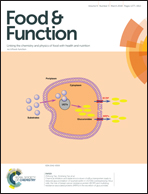Influence of rye flour enzymatic biotransformation on the antioxidant capacity and transepithelial transport of phenolic acids
Abstract
Phenolic acids have been reported to play a role on the antioxidant activity and other important biological activities. However, as most polyphenolics in food products are either bound to cellular matrices or present as free polymeric forms, the way they are absorbed has not been totally clear until now. Hydrolytic enzymes may act to increase functionalities in polyphenolic-rich foods, enhancing the bioaccessibility of phenolic compounds and minerals from whole grains. The aim of this study was to evaluate the action of tannin acyl hydrolase (tannase) on the total phenols, phenolic acid profile, antioxidant capacity and in vitro bioaccessibility of phenolic acids found in whole rye flour (RF). Besides increasing total phenols and the antioxidant capacity, tannase treatment increased the amounts of ferulic, sinapic and vanillic acids identified in RF, evidencing a new type of feruloyl esterase catalytic action of tannase. Vanillic and sinapic acids in tannase-treated whole rye flour (RFT) were higher than RF after in vitro gastrointestinal digestion, and higher amounts of transported vanillic acid through the Caco-2 monolayer were detected in RFT. However, the bioaccessibility and the transport efficiency of RF phenolic acids were higher than RFT. Underutilized crops like rye and rye-derived products may be an important source of phenolic acids. The tannase biotransformation, even influencing the total phenolics and antioxidant capacity of RF, did not increase the bioaccessibility of phenolic acids under the experimental conditions of this study.



 Please wait while we load your content...
Please wait while we load your content...